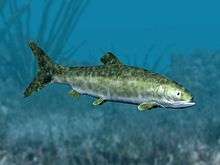Pholidophorus
| Pholidophorus Temporal range: Middle Triassic–Late Jurassic | |
|---|---|
 | |
| Scientific classification | |
| Kingdom: | Animalia |
| Phylum: | Chordata |
| Class: | Actinopterygii |
| Order: | Pachycormiformes |
| Family: | Pholidophoridae |
| Genus: | Pholidophorus Agassiz, 1832 |
| Species | |
| |
Pholidophorus is an extinct genus of teleost fish from the Triassic and Jurassic periods of Africa, Europe, and South America.


Pholidophorus was a herring-like fish about 40 centimetres (16 in) long, although it was not closely related to modern herring. Like them, however, it had a single dorsal fin, a symmetrical tail, and an anal fin placed towards the rear of the body. It had large eyes and was probably a fast-swimming predator, hunting planktonic crustaceans and smaller fish.[1]
A very early teleost, Pholidophoris had many primitive characteristics such as ganoid scales and a spine that was partially composed of cartilage, rather than bone.[1]
A contrary view
According to T.S. Kemp, "a single species of fish from the Jurassic, Pholidophorus bechii, is thought to be the sister-group" of all fossil and living teleosts.[2]
